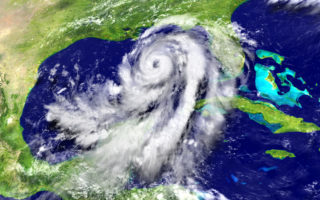HURRICANE HARVEY: ANTI-CONCURRENT CAUSATION REVISITED
Sep 6, 2017
Tragically, Hurricane Harvey has affected at least 50 Texas counties per Governor Abbott’s recent state disaster declaration. Harvey made landfall with 132 mph winds recorded near Port Aransas, Texas, with other areas recording anywhere from over 50 to 125 mph winds. And, there is storm surge, which was predicted to reach up to 12 feet in some areas. Even more astounding, however, is the massive rainfall as a result of Harvey. As of August 30, 2017, a reading at Cedar Bayou outside of Houston reflected 51.88 inches of rain, with other affected areas recording 25 to 49 inches of rainfall.
According to CoreLogic, a global analytics firm, 52% of Houston’s residential and commercial properties are located outside of FEMA-designated Special Flood Hazard areas. Only those residents with properties located in a flood hazard area are required to purchase flood insurance by lenders, leaving many residents and business owners uninsured for flood. While likely in the minority of claims, some residents and businesses will have flood insurance underwritten in the private market. Nevertheless, insureds will make claims with their property insurers because FEMA disaster assistance is available only for uninsured losses. Undoubtedly, insurers will receive claims involving damages potentially resulting from a covered cause of loss (wind, fire, theft, etc.) and damages that are excluded (water). These types of claims can lead to coverage issues centering around causation.
Texas courts have not adopted the application of the “efficient proximate cause rule,” used in other states, which determines coverage by the relative contribution of the covered and excluded perils to the property damage. Instead, Texas follows what is known as the doctrine of concurrent causation. See Travelers Indem. v. McKillip, 469 S.W.2d 160, 163 (Tex. 1971); Wallis v. United Serv. Auto. Ass’n, 2 S.W.3d 300 (Tex. App.—San Antonio 1999, pet. denied). Under the doctrine of concurrent causation, when covered and uncovered perils contribute to a loss, the insured is allowed to recover that portion of the damage caused solely by the covered peril. Wallis, 2 S.W.3d at 304. The burden is on the insured to allocate the damages between covered and uncovered damages. The Texas Supreme Court has held: “When covered and excluded perils combine to cause an injury, the insured must present some evidence affording the jury a reasonable basis on which to allocate the damage.” Lyons v. Millers Cas. Co., 866 S.W.2d 597, 606 (Tex. 1993). If the insured fails to demonstrate a reasonable basis for allocation, the damages are not covered.
When covered and uncovered causes combine to concurrently cause a loss, and those causes of loss cannot be separated (such as storm-related damage due to wind and flood), the insured can face a more difficult challenge. This type of scenario may implicate a property policy’s anti-concurrent causation (“ACC”) clause.
Most non-flood property insurance policies include water damage exclusions with anti-concurrent causation (“ACC”) language, such as:
[The insurer] will not pay for loss or damage caused directly or indirectly by [sources identified in the water damage exclusion]. Such loss or damage is excluded regardless of any other cause or event that contributes concurrently or in any sequence to the loss.
The ACC clause precludes coverage for damage caused concurrently by a covered peril and a non-covered peril, regardless of which event was the proximate or pre-dominate cause of the loss.
The ACC clause became frequently litigated following Hurricane Katrina, allowing the Fifth Circuit to weigh in on its application.See Leonard v. Nationwide Mut. Ins. Co., 499 F.3d 419 (5th Cir. 2007) (interpreting Mississippi law). In Leonard, the home in question was twelve feet above sea level on the southernmost edge of Pascagoula, Mississippi, less than two hundred yards from the Mississippi Sound. Hurricane Katrina brought Pascagoula torrential rain and sustained winds in excess of one hundred miles per hour. The storm brought ashore a formidable tidal wave—also called a storm or tidal surge—flooding the ground floor of the two-story home. See id. at 423-24.
Inspection of the home following the storm revealed modest wind damage, with some broken roof shingles and loss of ceramic granules, but its water-tight integrity was not compromised. The non-load-bearing walls of the garage and the garage door were severely damaged; doors in the house and garage had been blown open; and a “golf-ball sized” hole in a ground-floor window was likely caused by a wind-driven projectile. On the other hand, water damage was extensive. The neighborhood where the home was located had suffered a seventeen-foot storm surge, causing the entire ground floor of the home to become inundated under five feet of water blown ashore. Walls, floors, fixtures, and personal property sustained extensive damage, while the second floor remained unscathed. See id. at 426. Nationwide concluded that damages caused by water and the storm surge’s concurrent wind-water action were barred, respectively, by the water-damages exclusion and the ACC clause. See id. Nationwide was unsuccessful at the trial court and appealed. The Fifth Circuit reversed.
The court held that the ACC clause in the policy unambiguously excluded coverage for water damage “even if another peril,” e.g., wind, contributed concurrently or in any sequence to cause the loss. The court noted that the plain language of the policy left the district court no interpretive leeway to conclude that recovery was available for wind damage that “occurred concurrently or in sequence with the excluded water damage.” See id. at 430.
The court explained the district court’s fatal flaw in reasoning was its failure to recognize the three discrete categories of damage at issue: (1) damage caused exclusively by wind; (2) damage caused exclusively by water; and (3) damage caused by wind “concurrently or in any sequence” with water. The court found that the classic example of such a concurrent wind-water peril is the storm-surge flooding that follows on the heels of a hurricane’s landfall, and that the only species of damage covered by the policy is damage caused exclusively by wind. But, if wind and water synergistically caused the same damage, the damage is excluded. See id.
Before litigation involving Hurricanes Ike and Katrina, the Texas Supreme Court had not decided whether or to what extent an ACC clause was enforceable. In 2015, however, the supreme court weighed in on the ACC clause’s application and enforceability.See JAW The Pointe, L.L.C. v. Lexington Ins. Co., 460 S.W.3d 597 (Tex. 2015). JAW involved a commercial property loss resulting from Hurricane Ike. The insurer, Lexington, and the insured, JAW, did not dispute that the damage at issue was caused by wind and flood. The issue was whether JAW’s ordinace-compliance repairs mandated by the City of Galveston were covered. See JAW, 460 S.W.3d at 608. The court of appeals concluded that Lexington’s policy did not cover JAW’s ordinance-compliance costs because the property damage that caused the ordinance-compliance losses resulted, at least in part, from flooding, which was an excluded cause of loss, and that the operation of Lexington’s ACC clause barred recovery for that damage.
At the Texas Supreme Court, JAW argued that the court of appeals erred because: (1) JAW met its evidentiary burden by showing that the wind damage was sufficient to be a “separate and independent” cause of its ordinance-compliance losses; (2) the court of appeals improperly shifted the burden of proof by requiring JAW to prove that the city segregated between wind damage and flood damage when it decided that the property was “substantially damaged”; and (3) the anti-concurrent-causation clause did not apply when a covered peril (wind) is a “separate and independent cause” of the loss.
Despite JAW’s argument that it could demonstrate separate and independent damage caused by a covered cause of loss, the supreme court held it “must evaluate JAW’s claim . . . in light of the policy’s anti-concurrent-causation clause, not the common-law concurrent-causation doctrine that [it] addressed in cases involving policies that did not include a similar clause. Id. at 608. In affirming the appellate court’s holding, the supreme court noted that the ACC clause provided that Lexington would not pay for any “loss or damage caused directly or indirectly by any” excluded cause or event, “regardless of any other cause or event that contributes concurrently or in any sequence to the loss.” The court was persuaded by the Fifth Circuit’s and intermediate Texas appellate courts’ precedent on ACC clauses,[1] holding:
The Fifth Circuit in particular has had the opportunity to develop case law on anti-concurrent-causation clauses in situations involving combinations of covered wind damage and excluded flood damage, and has concluded that ‘[t]he only species covered under [a policy with an anti-concurrent-causation clause] is damage caused exclusively by wind. But [when] wind and water synergistically cause[ ] the same damage, such damage is excluded.’ Leonard, 499 F.3d at 430; see also ARM Props., 400 Fed. Appx. at 941 (quoting same language). We agree with the Fifth Circuit that, under Texas law, the anti-concurrent-causation clause and the exclusion for losses caused by flood, ‘read together, exclude from coverage any damage caused by a combination of wind and water.’ Id.
Id. at 607-08.
While JAW confirmed that ACC language is enforceable, it is important to note that causes of loss (wind and flood) were not disputed under the facts of the case. Situations are likely to arise when a policyholder advocates that damage was caused solely by a covered cause of loss (wind, fire, theft) with no damage attributed to an uncovered cause, such as flood or water. Moreover, in areas in which high winds occurred, arguments are likely to be raised that wind-created openings caused damages, and not flood waters. Additionally, the actual wording of ACC clauses will be important. Slight differences in wording could affect the application of the ACC clause depending upon the facts.
The wind versus flood dispute also affects the handling of other significant coverages to insureds affected by Hurricane Harvey. Under a homeowner’s policy, additional living expense coverage is premised on a covered loss. Similarly, commercial property policies usually provide that business interruption coverage is tied to covered property damage. The ordinance coverage at issue in JAW The Pointewas tied to whether covered property damage existed. Civil authority coverage likewise depends on whether damage is attributed to a covered cause of loss. If all of the property damage is excluded based upon the ACC clause, these ancillary coverages should not be afforded.
Insurers will undoubtedly face claims from Harvey in which ACC language in policies will be challenged. Texas law is now certainly favorable to insurers, but whether an ACC provision is enforceable will likely depend on its language and the specific facts of the claim.
[1] See, e.g., ARM Props. Mgmt. Group v. RSUI Indem. Co., 400 Fed. Appx. 938, 941 (5th Cir. 2010); Leonard v. Nationwide Mut. Ins. Co., 499 F.3d 419, 429–31 (5th Cir. 2007) (interpreting Mississippi law); Lexington Ins. Co. v. Unity/Waterford–Fair Oaks, Ltd., 2002 WL 356756 at *4 (N.D. Tex. Mar. 5, 2002); Wong v. Monticello Ins. Co., 2003 WL 1522938 at *1 (Tex. App.–San Antonio Mar. 26, 2003, pet. denied).


